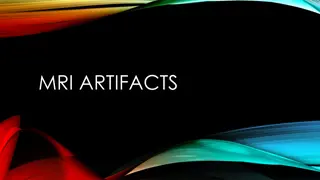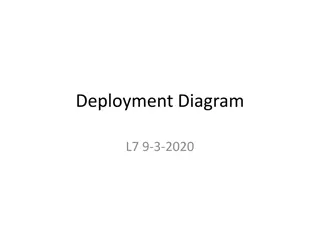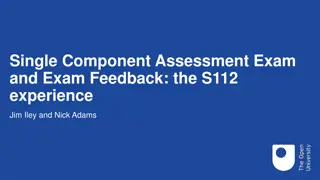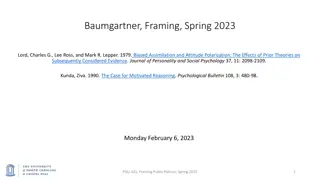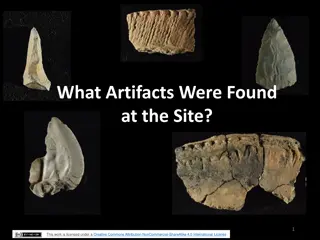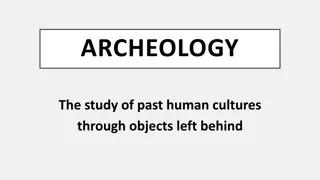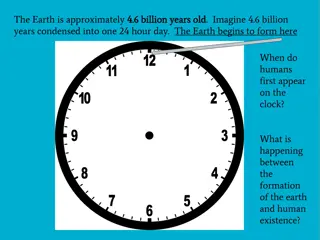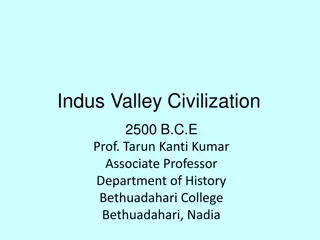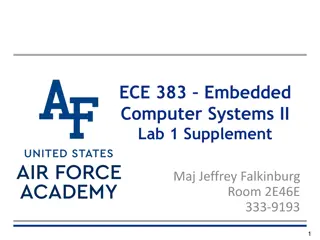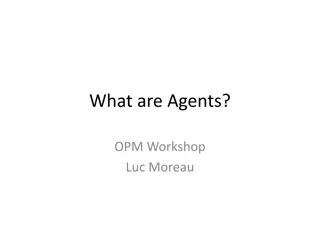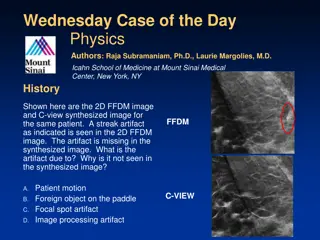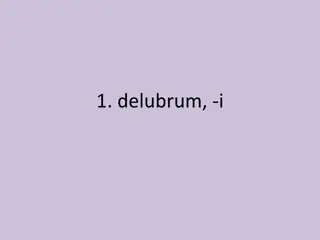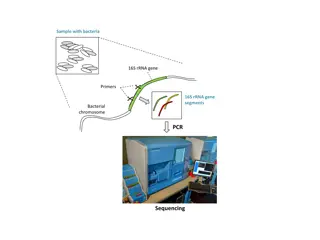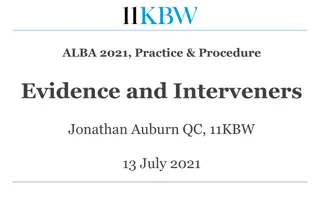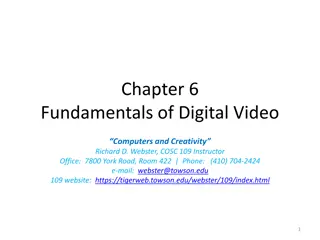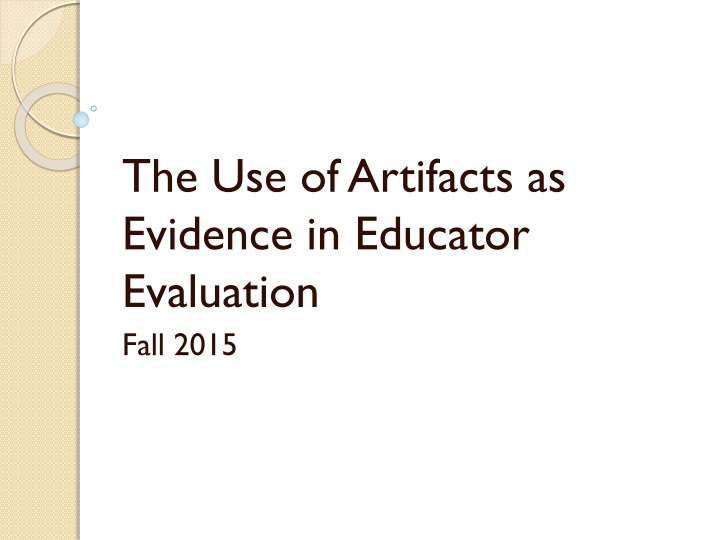
Utilizing Artifacts in Educator Evaluation Process
Explore the importance of artifacts as evidence in educator evaluation processes, including the three categories of evidence required by the Oregon Framework. The content delves into the role of artifacts, efficient evaluation processes, self-reflection, evidence identification, and the significance of continuous learning. Learn about the different types of evidence, such as measures of student learning, evidence related to professional practice, and evidence concerning professional responsibilities.
Download Presentation

Please find below an Image/Link to download the presentation.
The content on the website is provided AS IS for your information and personal use only. It may not be sold, licensed, or shared on other websites without obtaining consent from the author. If you encounter any issues during the download, it is possible that the publisher has removed the file from their server.
You are allowed to download the files provided on this website for personal or commercial use, subject to the condition that they are used lawfully. All files are the property of their respective owners.
The content on the website is provided AS IS for your information and personal use only. It may not be sold, licensed, or shared on other websites without obtaining consent from the author.
E N D
Presentation Transcript
The Use of Artifacts as Evidence in Educator Evaluation Fall 2015
Outcomes Explain the three categories of evidence required by the Oregon Framework, and identify concrete examples of each Understand the role of artifacts in the evaluation process Identify a process that is efficient and effective and reduces redundancy 2
Self Reflection Summative Evaluation Goal Setting Continuous Learning Observation/ Collection of Evidence Observation/ Collection of Evidence Formative Assessment/Eval uation Every educator and evaluator gathers evidence and assesses progress Every educator and evaluator gathers evidence and assesses progress 3
Activity: Identifying Evidence Review the Student Growth and Professional Goal Setting form for Tom Wilson Write down two artifacts of evidence that could be collected to show progress toward each goal Share Out 4
Three Categories of Evidence 1. Measures of student learning & growth 2. Evidence relevant to professional practice o Observations o Artifacts 3. Evidence relevant to professional responsibilities o Includes evidence collected by the educator and shared with the evaluator relating to progress toward professional goals 5
What is Evidence? Evidence is the available body of facts or information indicating whether a belief or proposition is true or valid signs; indications Can be gathered on stage or off stage
On Stage vs. Off Stage On Stage (Observations) What is seen Aspects of teaching/leadership that are directly observable Off Stage (Artifacts) Behind-the-scenes work that has a significant impact on learning
Artifacts Artifacts should be samples that demonstrates educator performance and impact Aligned with educator goals, the Oregon Model Core Teaching Standards, Oregon Educational Leadership/Administrator Standards, your district s rubric, or school/district goals
Possible Artifacts for Teachers Professional Practice Related to Standards Multiple Measures of Student Learning & Growth Student work (quizzes, homework, presentations, etc.) Portfolios Performance assessments Interim assessments State or district assessments Professional Responsibilities Related to Standards Student and staff feedback Grade-level meeting notes Parent/teacher communication log PLC meeting notes Documentation of Professional Learning Teacher-developed unit assessments Lesson Plans Notes/feedback forms from short, frequent observations (inside/outside classrooms) Notes and feedback from announced observations Email communications between educator and evaluator tied to practice 9
Possible Artifacts for Administrators Professional Practice Related to Standards Multiple Measures of Student Learning & Growth Building Rankings (School growth, sub- group growth) Graduation Rate* Discipline Data* National, international, district or school-wide developed assessments Professional Responsibilities Related to Standards Staff survey results Parent/Principal communications PTA meeting notes Self-reflection School/District Improvement Plan Professional Goal Setting Master Schedule Staff Retention Rate Documentation of Distributive Leadership (shared leadership) Staff meeting plans/agendas Log of observations Notes/feedback from observation meeting Notes and feedback from observation/post observation conference Surveys about instructional leadership Staff Communication Teacher Professional Development *Not applicable to principals
On Stage Activity: Fact vs. Opinion Examine Handout 2 Highlight factual statements Underline opinion statements or statements not based on evidence
On Stage Activity: Share Out What are some factual statements from the observation? What are some opinion statements? How could an opinion statement be revised into a factual statement?
Off Stage Activity: Examining Artifacts Examine the artifacts submitted by Tom Identify the areas of practice and responsibility within your district rubric you believe each artifact supports
Off Stage Activity: Share Out What questions or feedback would you have? Is there anything else you would want to know from Tom?
What does the Framework say? The educator and evaluator collect evidence using multiple measures regarding student learning and growth, professional practice, professional responsibilities, and student learning to inform progress throughout the process of evaluation Provides examples of artifacts for PP and PR www.ode.state.or.us/search/page/?id=3637
How much is enough? OR 1 6
Setting Your District Up for Success Get Organized Be Strategic Communicate Expectations Provide Professional Learning
1. Get Organized Adopt a process for organizing artifacts by Standard or Indicator and/or goals: Paper-based, email-driven, or online cloud- based system Identify key points of contact throughout the year to review artifacts Assign Responsibility Educator collects and submits artifacts throughout the evaluation cycle Evaluator organizes and analyzes artifacts 18
2. Be Strategic The more focused the Student Learning and Growth and Professional Goals, the easier it is to identify and collect artifacts Share examples of artifacts during faculty or team meetings that provide evidence of more than one Standard or Indicator Identify common artifacts that all or most educators might already be collecting (unit assessments, parent-teacher logs, etc.) Number of artifacts to collect varies by educator 19
3. Communicate Expectations Artifacts should be samples that demonstrates educator performance and impact Evidence should be clearly tied to educator goals, Standards, or Indicators Provide everyone with a clear idea of what, how, and when to share products of practice 20
4. Provide Professional Learning Develop a common understanding within the district of what quality artifacts look like Provide opportunities for calibration to ensure consistency 21
Possible Processes Artifacts reviewed through the lens of the performance rubric vs. artifact tool Choice of artifacts left up to educator and evaluator vs. district required list of artifacts Other?
Discussion and Planning Use Handout 8 in your packet to work with your team or other colleagues to think about this might work in your district
Resources Toolkit www.ode.state.or.us/search/page/?id=3759 ODE recommended rubrics artifact templates Missouri Artifact Tool Resources from Districts www.ode.state.or.us/search/page/?id=3853 David Douglas Artifact Ideas for Danielson Specialist Rubrics Salem Keizer (specialists) Lebanon (non-building administrators) Additional technical assistance from ODE
Contacts Educator Effectiveness Team: Tanya Frisendahl tanya.frisendahl@state.or.us Sarah Martin sarah.martin@state.or.us Sarah Phillips sarah.phillips@state.or.us Brian Putnam brian.putnam@state.or.us




